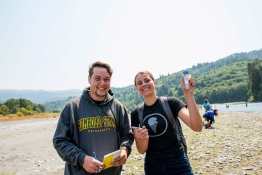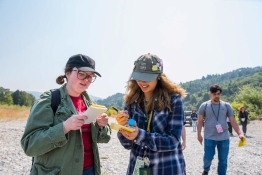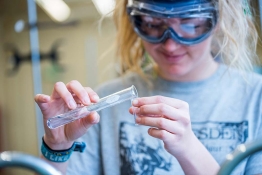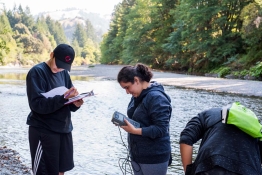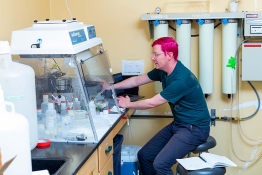Achievements
Publications and achievements submitted by our faculty, staff, and students.
Faculty William F. Wood Chemistry
Professor William Wood was recently interviewed in an _Outside_ magazine article on skunk spray. Wood specializes in chemical ecology, or the way plants and animals use chemicals to convey messages in nature. He is an Emeritus Professor in Chemistry. For the full "article":http://www.outsideonline.com/outdoor-adventure/nature/On-the-Very-Smell….
Submitted: July 15, 2014Faculty William Wood Chemistry
William Wood was the winner of the “Most Likely to Change the World” award for his research commentary on The Academic Minute. This broadcast was part of Northeast Public Radio’s daily program on research from campuses around the world.
Submitted: August 20, 2012Faculty William Wood Chemistry
Professor William Wood and student co-authors Jay A. Brandes, Brian D. Foy, Christopher G. Morgan, Thierry D. Mann and Darvin A. DeShazer published a report on the maple syrup odor of the candy cap mushroom. The project culminated 25 years of research, since identification of the chemical responsible for the unique odor has been elusive. The odor causing chemical, quabalactone III, is not present in living candy cap mushrooms. It is only found in dried mushrooms and likely results from the reaction of a rare amino acid on desiccation.
This research was published in Biosystematics and Ecology [Volume 43, 51-53 (2012)].
Submitted: April 23, 2012Faculty William Wood Chemistry
William Wood published a report on the volatile organic compounds from first year canes of the invasive Himalayan blackberry. Succulent young leaves had chemicals that were not present in mature leaves. These chemicals showed significant activity against the feeding of banana slugs and are known to repel aphids.
Banana slug antifeedant in the growing cane tips of Himalayan Berry, Rubus armeniacus. William F. Wood. Biochemical Systematics and Ecology 41, 126-129 (2012).
Submitted: April 3, 2012Faculty William F. Wood Chemistry
On Jan. 26, 2012, Professor Wood presented a worldwide American Chemical Society WebinarTM to 500 participants titled: Chemistry Stinks! And How Nature Uses These Noxious Chemicals. The webinar consisted of a 20 minute presentation of his research on skunks, giraffes, garter snakes, wolverines and weasels followed by 30 minutes of questions and answers from the audience. The program was moderated by Professor Darren Griffin, University of Kent, UK. In the future, this ACS Webinar will be available for viewing at http://acswebinars.org/.
Submitted: January 26, 2012Faculty William Wood Chemistry
An article titled “The Triangle in Photographic Composition,” and four of his photographs were published in the October issue of Redwood Snapshots, a publication of the Redwood Camera Club.
The article explores the field of Gestalt psychology for possible reasons why the triangular form enhances photographic composition. Gestalt psychology explains why people perceive visual components as organized patterns or wholes, instead of many different parts. The generation of triangular images where none exist is a major illustration of the Gestalt theory. This helps explain why photographs that contain triangular forms can have higher impact than those that don’t.
Submitted: October 10, 2011Faculty William Wood Chemistry
William Wood published a report on the identification of 2-ethyl-3-methylpyrazine from the scent glands of male pronghorn antelope. Previously, this hazel nut odor compound has only been identified from plants and is likely used in territorial marking by these animals.
2-Ethyl-3-methylpyrazine in the subauricular and median glands of pronghorn, Antilocapra americana. William F. Wood. Biochemical Systematics and Ecology 39, 159-169 (2011).
Submitted: May 5, 2011Faculty William Wood Chemistry
William Wood, Terrence McGlynn (CSU Dominguez Hills) and the student, Thuy-Tien Hoang, reported their research on the alarm pheromones of Costa Rican turtle ants ants.
Volatile components from the mandibular glands of the turtle ants, Cephalotes alfaroi and C. cristatus. William F. Wood, Thuy-Tien Hoang, Terrence P. McGlynn. Biochemical Systematics and Ecology 39, 135-138 (2011).
Submitted: April 4, 2011Faculty William Wood and Warren Wood Chemistry
William Wood and Warren Wood (University of Portland) and three of their undergraduate students had their research on western thatching ants published.
Chemical analysis of the defensive secretion from the western thatching ant, Formica obscuripes. Gloriane W. Faith, Brian G. Solliers, Rachel M. Feeny, Warren J. L. Wood and William F. Wood. Journal of Undergraduate Chemistry Research 10, 15-17 (2011).
Submitted: March 28, 2011Faculty William Wood Chemistry
On February 9, William Wood, HSU Chemical Ecologist gave a lecture to the California Native Plant Society: titled “Chemicals – the Language of Plants.” This talk covered how plants use chemical to "talk to other plants.” It also covered many of the toxic compounds plants make to keep from being eaten. Humans now use many of these toxic plant compounds as modern medicinal drugs.
Submitted: February 10, 2011Faculty William F. Wood Chemistry
A major focus of William Wood's research has been the investigation of antibiotics naturally excreted from mammalian skin glands. This December his latest contribution to this area was published in Scientia Pharmaceutica, the Austrian Journal of Pharmaceutical Sciences. It describes a series of antimicrobial compounds that were prepared using a compound from an African antelope as a model.
William F. Wood, “Synthesis and Antimicrobial Activity of Long-Chain 3,4-Epoxy-2-alkanones” Scientia Pharmaceutica 78, 745-751 (2010). doi:10.3797/scipharm.1009-02
Submitted: December 7, 2010Faculty William Wood Chemistry
An article titled “Bird Photography” and 12 photographs was published in the November issue of Redwood Snapshots, a publication of the Redwood Camera Club.
Photographing birds has long been an important aspect of William Wood’s nature photography. In this article he describes techniques for successfully photographing these animals
Submitted: November 17, 2010Faculty Richard A. Paselk Chemistry
Rich Paselk (Chemistry) presented a paper (5 October 2010) at the XXIX Symposium of the Scientific Instrument Commission of the International Union for the History and Philosophy of Science in Florence, Italy : "The Display of 20th-Century Scientific Instruments at Humboldt State University,"
Submitted: November 2, 2010Faculty Matthew Hurst Chemistry
Published an article in the journal Continental Shelf Research on the unusually high levels of bioavailable particulate iron and how it may be responsible for the high productivity found on the Bering Sea shelf.
Hurst, Matthew P., Aguilar-Islas, Ana M., and Kenneth W. Bruland (2010). Iron in the southeastern Bering Sea: Elevated leachable particulate Fe in shelf bottom waters as an important source for surface waters. Continental Shelf Research, 30, 467-480.
Submitted: October 1, 2010Faculty Kjirsten Wayman Chemistry
Published an article in the journal Phytochemistry on the chemotaxonomy of plant species in the genus Pseudowintera, a New Zealand endemic genus.
Kjirsten A. Wayman, Peter J. de Lange, Lesley Larsen, Catherine E. Sansom, Nigel B. Perry, “Chemotaxonomy of Pseudowintera: Sesquiterpene dialdehyde variants are species markers”, Phytochemistry 2010, 71, 766-772.
Submitted: September 1, 2010Faculty Joshua R. Smith Chemistry
Jun Zhu, Christian Dahlstrand, Joshua R. Smith, Sébastien Villaume, and Henrik Ottosson; Symmetry 2010, 2(3), 1653-1682
On the Importance of Clar Structures of Polybenzenoid Hydrocarbons as Revealed by the π-Contribution to the Electron Localization Function
http://www.mdpi.com/2073-8994/2/3/1653/
Submitted: September 1, 2010Faculty William Wood Chemistry
An article titled "Candid Photographic Portraits" and 9 photographs was published in the September issue of Redwood Snapshots, a publication of the Redwood Camera Club.
Candid photography, sometimes called “street photography,” has long been an important aspect of William Wood's phtography. It involves taking photos of people acting spontaneously in their natural environment. These photographs preserve an instant in people’s lives when they are relaxed and behaving naturally.
Submitted: August 31, 2010Faculty William Wood Chemistry
William F. Wood, Jeffrey P. Copeland, Richard E. Yates, Iman K. Horsey, Lynne R. McGreevy. (2009). Potential semiochemicals in urine from free ranging wolverines (Gulo gulo Pallas, 1780). Biochemical Systematics and Ecology 37: 574–578
Submitted: August 27, 2010Faculty Willliam Wood Chemistry
William F. Wood, Aya Kubo, Tony B. Shaffer (2010). Antimicrobial activity of long-chain (E)-3-alken-2-ones. Bioorganic & Medicinal Chemistry Letters 20: 1819–1820.
Submitted: August 27, 2010
